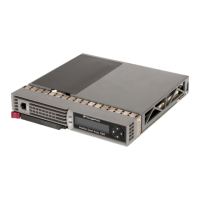Installation Procedures - for all MSA1000 Deployments
22 MSA1000 Installation Guide
■ When planning your LUNs, set the drive rebuild priority of your LUNs to
“high” to minimize exposure during a drive failure.
■ When planning your LUNs, to optimize performance and redundancy in a
mirrored environment (RAID 1 or RAID 1+0), stripe the drives in the array
across the separate buses within the MSA1000 and any attached storage
enclosures.
For example, because drive bays 1-7 in the MSA1000 are located on bus 1
and drives 8-14 are located on bus 2, when creating a mirrored array with 6
drives, include the drives in bays 1, 2, 3 and 8, 9, 10.
■ In a SAN with multiple servers, HP recommends designating one of the
servers as a management server, to centralize your management tasks.
It is on this server that you will install management software such as the ACU,
and it is from this server that you will perform your SAN management tasks.
■ Before installing your MSA1000, consider redundancies of power, storage,
and data paths.
— To provide redundant power, be sure to plug the two power supplies on
the MSA1000 into separate Uninterruptable Power Supplies (UPS) on
separate sources of power. If you have only one UPS, maintain separate
power paths by plugging one MSA1000 power supply to the UPS on one
power source and plug the other MSA1000 power supply to a separate
power source.
— To provide redundant storage, configure your LUNs using fault-tolerant
RAID levels and striping methods. If you have additional storage
enclosures attached to the MSA1000, consider striping the array
vertically and include drives from each enclosure, to maximize hardware
fault tolerance and I/O performance.
— To provide redundant data paths, you must include two isolated fibre
channel fabrics and the associated hardware and software components in
the configuration. You must include two MSA1000 controllers, two Fibre
interconnect devices, and two HBAs in each server. Environments using
Secure Path software must install the software on each server.

